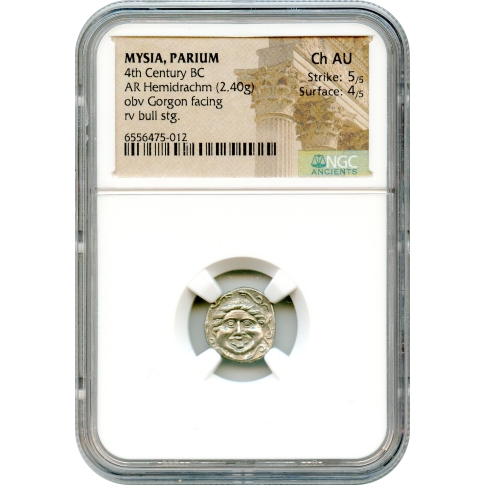Ancient Greece - 400-300 BCE Mysia, Parium AR Hemidrachm NGC Choice AU
MYSIA. Parium, c. 4th Century BC. AR hemidrachm (2.40 g). NGC Choice AU, 5/5, 4/5. Obverse: head of Gorgoneion facing out with tongue protruding below upper row of teeth. Coiled snakes about. Reverse: Bull standing left, with head to the right and ivy leaf below. ΠA/PI. SNG Copenhagen 266.

Gorgoneion upon the Tondo of an ancient Greek Attic black-figure cup, c. end of 6th Century BC, from Cabinet des médailles de la Bibliothèque nationale de France, Paris, France. Image: Wikimedia Commons.
In ancient Greek culture, the Gorgoneion (Greek: Γοργόνειον) was an apotropaic amulet that displayed the Gorgon head, which was used by Olympian deities Athena and Zeus. It is believed that both of them wore the gorgoneion as a defensive pendant, and are often presented wearing it. Wearing it established their heritage from previous deities. Among other powers, it was assumed by rulers from the Hellenistic Age as a royal aegis that represented divine birth or protection, as presented, for example, upon the Alexander Mosaic and the Gonzaga Cameo.
| Grading Service | NGC |
|---|---|
| Year of Issue | NONE |
| Grade | AU55 |
| Denom Type | Ancient |
| Numeric Denomination | AR Hemidrachm |
| Mint Location | NONE |
| Designation | NONE |
| Circ/UnCirc | Circulated |
| Strike Type | Business |
| Holder Variety | Strike 5/5; Surface 4/5 |
| Grade Add On | NONE |
| Holder Type | N/A |



